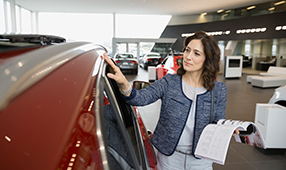Key takeaways
- Research—and negotiations—can help you get the best new car, for the best price.
- Understanding the “vocabulary” of dealerships can make you a wiser shopper.
- Comparing financing options can lower your monthly payments.
- Reading service contracts carefully can ensure that everything is covered.
A new car is second only to a home as the most expensive purchase many consumers make. According to J.D. Power and LMC Automotive, the average price of a new car sold in May 2018 was $32,380. That’s why it’s important for you to know how to make a smart deal. So consider the following recommendations about key stages of the process:
Buying your new car
Think about the model and options you want, and how much you’re willing to spend. Do research to get a better deal. Consider these suggestions:
- Check publications at a library, bookstore or on the Internet, such as such as Kelley Blue Book or Edmunds.com, that discuss new car features and prices. These resources will provide information about the dealer’s costs for specific models and options.
- Shop around to get the best possible deal by comparing models and prices in ads and at showrooms. Car-buying services, such as the NEA® Auto Buying Program, and broker-buying services also offer comparisons.
- Negotiate on price. Dealers are frequently willing to bargain on their profit margin, which is often between 10-20%. Usually, this is the difference between the manufacturer’s suggested retail price (MSRP) and the invoice price, so negotiating will save you money.
- Use options as a bargaining chip. If cars on the lot don’t include all of the features you want, then express this to the sales people. They want to sell their current inventory quickly, so they could cut you break if their in-stock inventory lacks something you seek.
Learning the terms
Negotiations often have a vocabulary of their own. Here are some terms you may hear when you’re talking price.
-
Invoice price is the manufacturer’s initial charge to the dealer. This is usually higher than the dealer’s final cost because the dealer receives rebates, allowances, discounts and incentive awards. Generally, the invoice price should include freight (also known as destination and delivery). If you’re buying a car based on the invoice price (for example, “at invoice,” “$100 below invoice,” “2% over invoice”), and if freight is already included, make sure freight isn’t added again to the sales contract.
- Base price is the cost of the car without options, but includes standard equipment and a factory warranty.
- Monroney sticker price (also known as MSRP) shows the base price, the manufacturer’s installed options with the manufacturer’s suggested retail price, the manufacturer’s transportation charge and the fuel economy (mileage). Affixed to the car window, this label is required by federal law and may be removed only by the purchaser.
- Dealer Sticker Price, usually on a supplemental sticker, is the Monroney sticker price plus the suggested retail price of dealer-installed options, such as undercoating.
Financing your new car
If you finance your car, be aware that the financing obtained by the dealer―even if the dealer contacts lenders on your behalf―may not be the best offer you can get. Contact lenders directly. Compare what they offer to what the dealer does. When negotiating to finance a car, be wary of focusing only on the monthly payment. The total amount you will pay depends on the price of the car you negotiate, the annual percentage rate (APR) of the interest to pay and the length of the loan.
Sometimes, dealers offer very low financing rates for specific cars or models. To qualify for the special rates, you may be required to make a large down payment. With these conditions, you could find that it’s sometimes more affordable to pay higher financing charges on a car that is lower in price, or to buy a car that requires a smaller down payment.
After you sign a contract to purchase or finance the car, obtain a copy of the contract that both you and the dealer have signed, with all blanks filled in.
Some dealers and lenders may ask you to buy credit insurance to pay off your loan, if you should die or become disabled. Before you buy credit insurance, consider the cost and whether it’s worthwhile. Check your existing policies to avoid duplicating benefits. Credit insurance is not required by federal law. If your dealer requires you to buy credit insurance for car financing, it must be included in the cost of credit. That is, it must be reflected in the APR.
Trading in your old car
Discuss the possibility of a trade-in only after you’ve negotiated the best possible price for your new car and after you’ve researched the value of your old car. Check the library or Internet for reference books, magazines or websites, such as Kelley Blue Book or Edmunds, that can tell you how much it’s worth. This information will help you get a better price from the dealer. Though it may take longer to sell your car yourself, you generally will get more money than if you trade it in.
Considering a service contract
Service contracts that you may buy with a new car provide for the repair of certain parts or problems. These contracts are offered by manufacturers, dealers or independent companies and may or may not provide coverage beyond the manufacturer’s warranty. Remember that a warranty is included in the price of the car while a service contract costs extra.
Before deciding to purchase a service contract, read it carefully and consider these questions:
- What’s the difference between the coverage under the warranty and the coverage under the service contract?
- What repairs are covered?
- Is routine maintenance covered?
- Who pays for the labor? The parts?
- Who performs the repairs? Can they be made at businesses other than the dealership?
- How long does the service contract last?
- What are the cancellation and refund policies?












